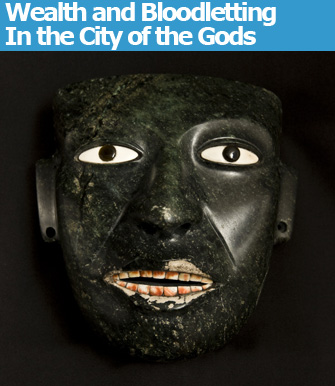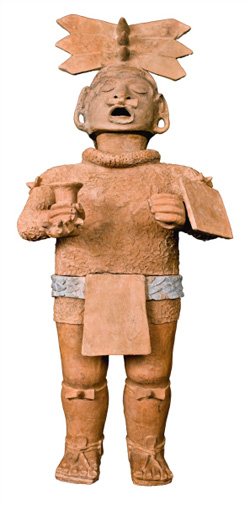 |
|
Mask fromTeotihuacan. © Consejo Nacional para la Cultura y las Artes, Instituto Nacional de Antropología e Historia, Mexico. Photo: Martirene Alcantara |
The lost civilizations of the pre-Columbian Americas are an endless source of fascination and often great mystery. The wealthy city of Teotihuacan in central …
 |
|
Mask fromTeotihuacan. © Consejo Nacional para la Cultura y las Artes, Instituto Nacional de Antropología e Historia, Mexico. Photo: Martirene Alcantara |
The lost civilizations of the pre-Columbian Americas are an endless source of fascination and often great mystery. The wealthy city of Teotihuacan in central Mexico, which grew from a village in 100 B.C.E. to a flourishing city, qualifies on both counts. The reasons for the violent destruction, burning and abandonment around 650 C.E. of what was one of the largest metropolises in the world in its time, with around 100,000 inhabitants, are not known, although it may have been due to an internal uprising. While it thrived, the traveling tradesmen of this mercantile civilization spread its influence throughout Mexico. Although the Aztecs later rediscovered the city, with its two pyramids and temple, they did not repopulate it but used it as a pilgrimage site.
“Teotihuacan: The City of the Gods,” the Musée d’Orsay’s current exhibition of treasures from Teotihuacan, many of them recent discoveries, is handsomely laid out (by Paris design agency Jakob + Macfarlane) in the museum’s spacious ground-floor gallery. On show are monumental pieces like a geometric jaguar (symbol of political power) sculpture from the city’s Xalla complex and two of the hundreds of serpent heads that adorned the walls around the Temple of Quetzalcoatl (Feathered Serpent), along with painted walls (teeming with colorful depictions of real and mythological animals) and dozens of statues, masks, figurines and other artifacts, including examples of “fine orange” pottery, a rare wooden scepter and a number of stone statues whose craftsmanship is all the more remarkable in that they were made without metal tools. The whole city is thought to have been painted in red and white.
The people of Teotihuacan practiced similar bloody sacrificial rituals known to us from the Aztecs and other Mesoamerican civilizations. One of the statues on show (pictured below) is particularly fascinating in this respect: a ceramic and stone statue identified as “Le Dieu Masqué” (“The Masked God”). Although the details of Teotihuacan’s religion and rituals are not known, it can be fairly safely inferred from the practices of later civilizations that this is a representation of Xipe Totec, a god who skinned himself to feed mankind. Accordingly, slaves being sacrificed to Xipe Totec were skinned after their hearts had been removed, and priests wore the victims’ flayed skin over their own for 20 days. Their emergence from the rotting skin symbolized rebirth.
 |
Statue of a masked god (Xipe Totec), wearing a sacrificial victim’s flayed skin inside-out. © Consejo Nacional para la Cultura y las Artes, Instituto Nacional de Antropología e Historia, Mexico. Photo: Martirene Alcantara font:minor-bidi;} |
Look closely at the statue: the strange texture of the god’s “garment” is the inside-out skin, which rolls down at the neck, of a sacrificial victim. Underneath the cup the god holds in his right hand is a second hand, that of the victim, and the “mask” he wears is the victim’s face. The bow ties on his head, arms and legs are symbols associated with bloodletting. None of this interesting information is noted on the label accompanying the statue (as usual at the Quai Branly, the labels are hard to read and often hard to find; make sure you pick up the booklet, available in English, at the entrance to the show).
Another statue, a chunky marble representation of a sacrificed prisoner with an oversized head and squared-off body, was found smashed to bits. It is highly unusual for its large size and white color. A close look reveals the incised image on his leg of an arrow or lance used to make his life-giving blood flow. The indentations on his arms show where the ropes that tied him to a post were attached.
Like these two pieces, each of the exhibits is not only an example of the artistry and craftsmanship of Teotihuacan but also has a story to tell, although we don’t always have the key to understanding it. Here are a few other clues to reading some of these pieces: figures with their arms crossed are sacrificial victims whose arms are tied behind their backs; the meaning of two circles on a figure’s head is not certain (the many recurring symbols found at Teotihuacan have not been definitively deciphered; those resembling drops of water are thought to be signs of wealth), but it may have been a symbol of social status; and the curvy, cartoon-like lines coming out of a figure’s mouth may represent either speech or the breath of life. The attributes of the feathered-serpent god Quetzalcoatl symbolically united the earth and sky.
Don’t miss this marvelous exhibition, which offers a peek into a civilization that may be alien to us but can’t help but intrigue with its obsession with blood and sacrifice. One last story: wealthy people would sometimes take a future sacrificial victim into their homes and treat him like an honored guest and friend for a month; when he was sacrificed, the host was sacrificing himself in proxy.
Musée du Quai Branly: 206 or 208, rue de l’Université, or 27, 37 or 51, quai Branly, 75007 Paris. Métro: Alma Marceau. RER: Pont de l’Alma. Tel.: 01 56 61 70 00. Open Tuesday, Wednesday and Sunday, 11 a.m.-7 p.m; Thursday, Friday and Saturday, 11 a.m.- 9 p.m. Admission: €7. Through January 24. www.quaibranly.fr
Buy related books and films from the Paris Update store.
More reviews of Paris art shows.
Reader Reaction
Click here to respond to this article (your response may be published on this page and is subject to editing).
© 2009 Paris Update
Favorite